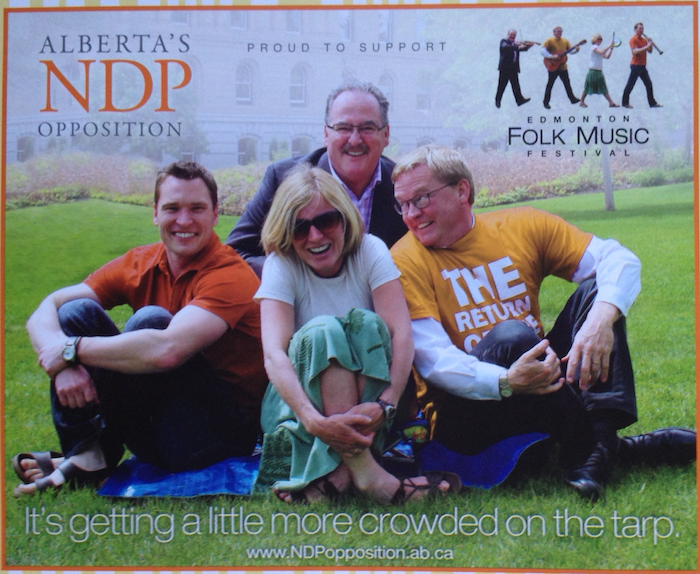
The Alberta NDP ad in the 2012 Edmonton Folk Music Festival program.
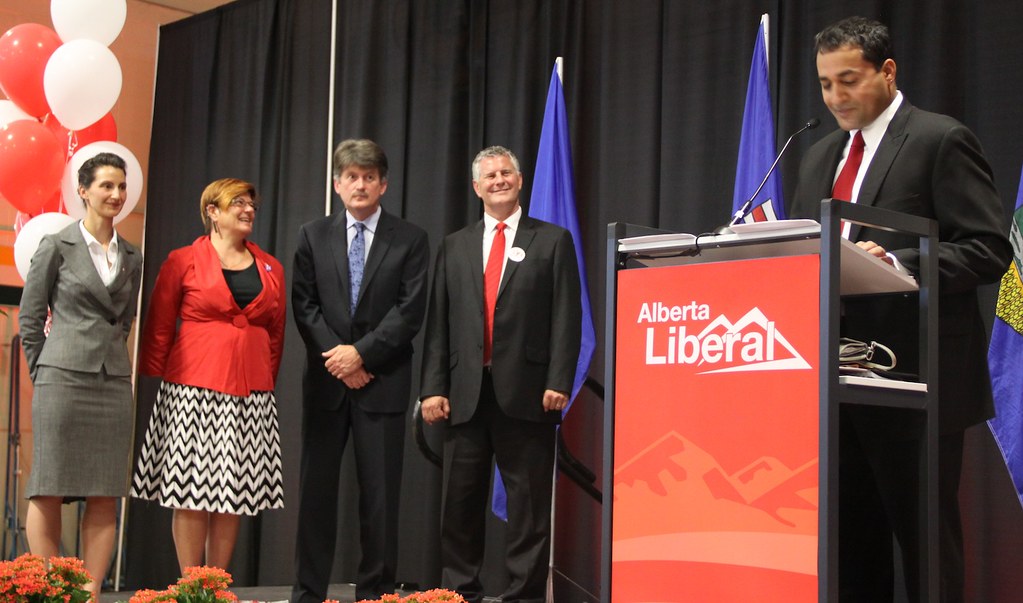
The Alberta Liberals will be holding a vote to affirm or oppose the continued leadership of Raj Sherman on June 16 at the Whitehorn Community Association in northeast Calgary.
While the 2012 election gave the Liberal Party its worst electoral showing in decades, including the loss of Official Opposition status to the Wildrose Party, many Liberal partisans are lining up to reaffirm Dr. Sherman’s leadership. Dr. Sherman was first elected as a Progressive Conservative MLA in 2008, became Liberal leader in 2011 and was re-elected as MLA for Edmonton-Meadowlark in the recent vote.
It is unclear where the Liberal Party fits in the new political environment and despite its dismal showing at the polls last month and it is disputable whether changing leadership at this time will improve that party’s electoral fortunes. Dr. Sherman’s biggest advantage in the June vote may be a lack of anyone else interested in taking up the unenviable position of trying to rebuild Alberta’s Liberal Party.
With only four other MLAs in the Assembly, the Liberals would have a small pool to draw from if Dr. Sherman were to leave. One of those MLA’s, David Swann, already served as leader from 2008 until 2011, and another, Laurie Blakeman, was defeated in the 2011 leadership contest.
Ms. Blakeman spent the past month campaigning to become the Speaker of the Assembly, which if she had won would have, for all intents and purposes, bumped the group of Liberal MLA’s down to 4. Ms. Blakeman was unsuccessful in her bid and was defeated by Edmonton-Mill Creek PC MLA Gene Zwozdesky, who himself crossed the floor from the Liberals to the PCs in 1998.
Calgary-Buffalo MLA Kent Hehr demonstrated ambition for higher office during his short-lived run for Mayor of Calgary in 2010, but has not publicly displayed interest in his party’s leadership position. I have little insight into whether Calgary-McCall MLA Darshan Kang would be interested in the role.
A few long-time Liberal partisans have shared their frustration with me, suggesting that if long-time Edmonton-Gold Bar MLA Hugh MacDonald had not decided to retire in the recent election, he would be in an ideal position to claim the party leadership. Mr. MacDonald placed second in that party’s 2011 leadership contest and many of his supporters continue to see Dr. Sherman as an outsider to their party.
Other Party Leadership Reviews
It is expected that PC Premier Alison Redford will face a leadership affirmation vote at her party’s annual convention next year. After leading her party to re-election, winning 61 of 87 seats, it is likely that her leadership will be strongly affirmed in the vote.
Wildrose Party leader Danielle Smith, now Leader of the Official Opposition, is required to face a leadership affirmation vote every three years, which means the next vote would be held in 2013 at the latest. Under section 8.4 of the Wildrose Party constitution, Ms. Smith leadership also faces conditions of term-limits:
8.4 The Leader shall be limited to holding the office of Leader of the Party for the longer of two terms of the Legislative Assembly or eight years, unless endorsed by a two-thirds majority to continue for an additional four years at the Annual General Meeting immediately preceding the expiry of the allowed term.
Both the Alberta NDP and the Alberta Party hold votes to affirm or oppose the current leadership at each annual general meeting, meaning that Brian Mason and Glenn Taylor will face votes in the upcoming year.
By: Richard Liebrecht
Going into the election, the two-person caucus of Brian Mason and Rachel Notley was well known among media insiders and observers for punching above their weight in earning coverage. Having served as communications officer for the caucus, I like to think I also played a small part in that excellent coverage. You get it by being relevant and timely.
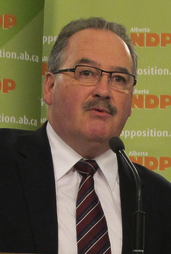
But relevancy and timeliness weren’t required this past election. New Democrats got solid coverage everyday. As did the Liberals, PCs and Wildrose. When I say solid, as a professional public relations practitioner (read: flack), I mean uncritical, straight-up recording of events and releases. I know that some press releases were literally re-written into stories and published.
Early in the campaign, the New Democrats sent Mason into a sports store to buy an Oilers jersey. Five cameras showed up just to get tape. It was way too easy.
Had it not been for a blogger talking about conscience rights and the Wildrose, and a P.C.-connected tweeter highlighting gay-damning comments from a Wildrose candidate, the election may have been nothing but a bunch of rehashed press releases and horserace stories.
I’m not here to slam reporters, however. I count many as friends, and I formerly worked for the Edmonton Sun.
Perhaps that’s why the slack coverage of the election is in my mind easily explained – this election was the product of a dwindling media presence in this province. It’s a national and international trend that’s seeing the reporting industry shrink while economies and populations are at historically large sizes.
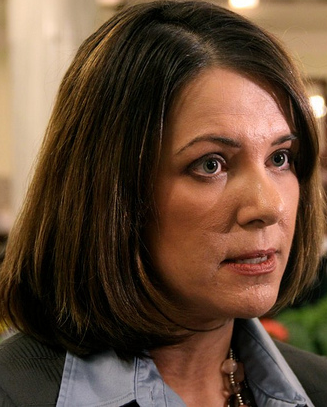
Firstly, newsrooms were under resourced this election. The Wildrose at times had only one reporter aboard their mammary motor coach, despite their surge in the polls. The reporters who may have been assigned to it were instead covering multiple campaigns in a day because there just weren’t enough bodies to put someone full time with each campaign.
I know that reporters had found Hunsperber’s blog, but didn’t have time to look through it extensively enough to find the trouble posting.
Secondly, editors are desperate to cover every bit of news available. Sounds good, but thanks to short staffing, they’ve been forced to choose: do original work and let some news slip by, or throw all your resources into making sure you have all the news that’s everyone else is doing. Their choice is evident when several cameras showing up for a guy buying a hockey jersey. Every station was worried they may not have the shot. And God help that editor if they tweet a picture of it 30 minutes later than another outlet. This is the blowfish act of outlets too proud to show that there’s little meat left on the bones.
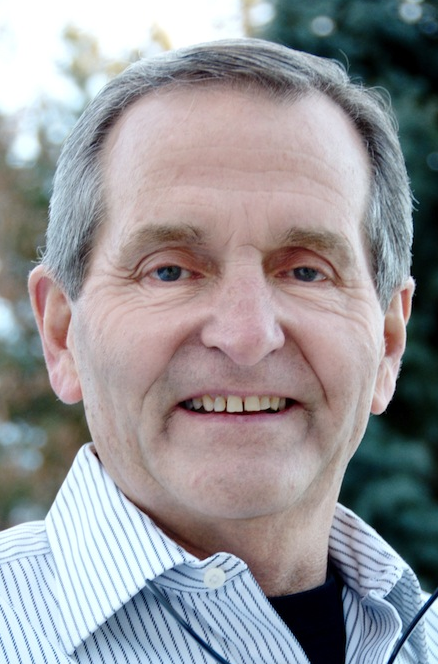
It’s scary to think that Hunsperger’s blog may not have come to light before Election Day. Premier Smith would have had damage control to do, no doubt – but also no one to answer to for four years. The tidal wave of strategic voting may never have been triggered. Who knows what else media missed?
While a shrivelled press corps makes getting out my story as a PR flack easier, as a citizen I know that’s a dangerous state. While truth can be relative, it is relatively objective. I hope and expect media will be out there wading through the facts and opinions with genuine, untainted curiosity to expose lies and half-truths. Media, at its best, is a bulwark of accountability. When that accountability dwindles, then so too does the warning of punishment for spinning half-truths and even lies, as some dishonourable members of my profession do. Corruption and confusion come unheralded and unstoppable.
None of this is inevitable in a growth society. As news consumers, we have two important choices to make. We can decide to reward enterprising journalism with our readership, or continue to loyally follow a shrunken media into irrelevance. We can decide to pay for subscriptions to good journalism, or we can continue to live under the illusion that news is free.
Demand news with insightful analysis, interesting human perspectives, exploration of new angles and lots of background research. And pay for it.
While handfuls of journalists will continue to lose their jobs if media continues to whither, it’s you who next election may unwittingly vote for someone or something you didn’t even know you were voting for.
Richard Liebrecht (@wardofcanada) is a public relations specialist. He’s formerly communications officer for Alberta’s NDP opposition, where he consulted on communication strategy. He’s also a former staff reporter at the Edmonton Sun. He blogs at wardofcanada.blogspot.com.
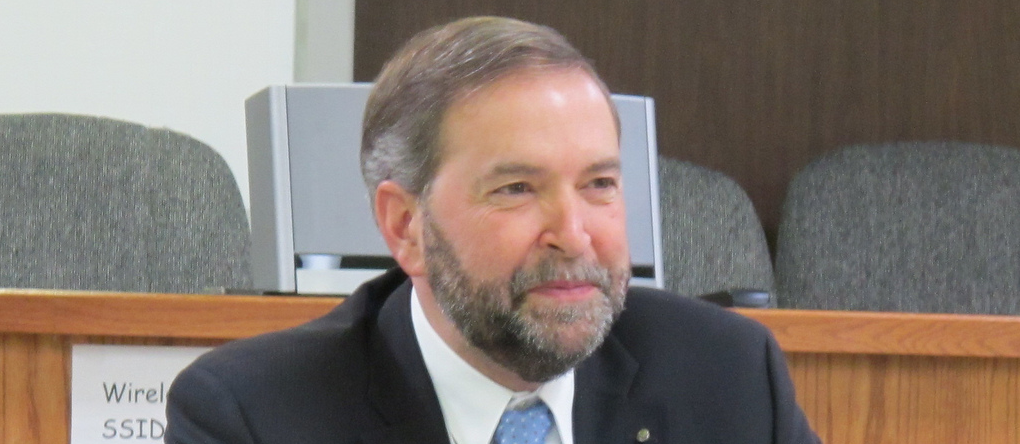
After weeks of warring words about the economic influence of Western Canadian oilsands development on the crumbling Central Canadian manufacturing sector, NDP leader Thomas Mulcair will visit Alberta on May 31 to meet with business and political leaders. This will be Mr. Mulcair’s first visit to Alberta since being selected as his party’s leader in March (he visited Alberta at least once during the NDP leadership contest).
In a media release distributed this morning, provincial NDP leader Brian Mason was quoted as saying “Tom and I had a conversation over the phone a couple of days ago, and I invited him to come to Alberta. I’m pleased that he agreed to come.”
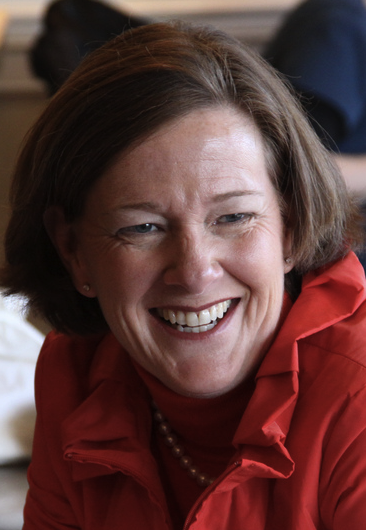
Mr. Mulcair’s comments that “Dutch Disease,” caused by Western natural resource development, is to blame for Central Canadian economic woes drew harsh criticism from Saskatchewan Premier Brad Wall and Alberta Premier Alison Redford. Premier Redford accused the Official Opposition leader of being “wrong and misinformed” on the issue. Alberta’s Minister of Environment and Sustainable Resource Development Diana McQueen accused Mr. Mulcair of “old-style politics — trying to pit one part of the country against another.” (on another note, Minister McQueen admitted today that Alberta has likely missed its greenhouse gas reduction targets).
Earlier this year, Ontario Premier Dalton McGuinty also publicly mused that the high Canadian dollar, caused as a results of Western natural resource development, was hurting Ontario’s economy.
The federal NDP currently have only one Member of Parliament from Alberta and it is likely that Edmonton-Strathcona MP Linda Duncan will play a prominent role in Mr. Mulcair’s day-trip to Alberta. During the recent provincial election, a number of NDP MP’s, including Olivia Chow, Jack Harris, Niki Ashton, and Peter Julian, visited the province to campaign alongside their provincial colleagues.
While the provincial NDP recently made electoral gains in Edmonton, doubling their caucus from 2 to 4 MLA’s, the party still faces tough criticism for perceived anti-oilsands positions. During the campaign, Mr. Mason argued that Alberta’s economy would benefit from building bitumen refineries in-province rather than shipping unrefined product internationally through pipelines and ocean tankers.
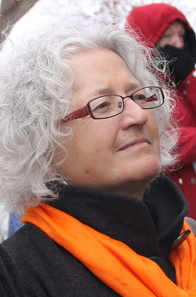
Mr. Mulcair’s visit will take place only days after the Premiers of Canada’s western provinces and territories meet in Edmonton for the Western Premiers’ Conference. The annual meeting is being held on May 29 at the Fairmont Hotel MacDonald in Edmonton.
While Mr. Mulcair’s comments will be a topic of small chat amongst the Premier’s and their staff, the topic of pipelines and international markets will likely be a hot topic on the agenda. As the only current NDP leader in government in western Canada, Manitoba Premier Greg Selinger might be the closest person Mr. Mulcair has as an ally at this meeting.
Faced with plummeting poll numbers, British Columbia Premier Christy Clark has expressed concern about the shipment of oilsands bitumen using the proposed Enbridge Northern Gateway Pipeline through northern BC. Riding high at 50% in the polls, BC NDP Leader Adrian Dix is opposed to the proposed Enbridge pipeline and is assembling a legal team to halt its construction.
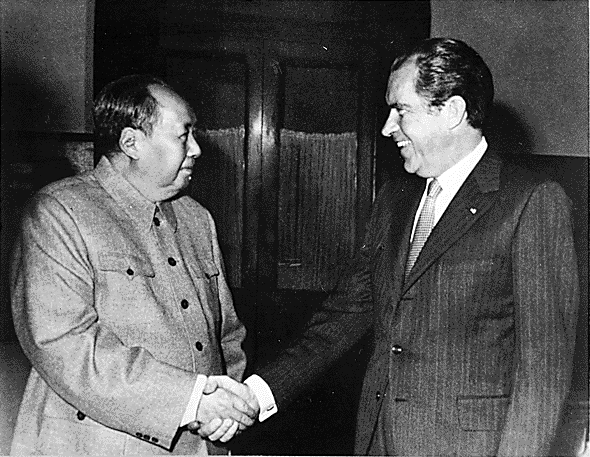
Three years after becoming leader of her party, Official Opposition Wildrose Party leader and southern Alberta MLA Danielle Smith met with Edmonton Mayor Stephen Mandel for the first time yesterday.
It is bizarre that Ms. Smith, who believed she was on the verge of becoming Premier of Alberta before April 23, had not met the Mayor of Alberta’s capital city until today. Knowing how many events Mayor Mandel attends on a weekly basis it is surprising to me that the two have not coincidentally (or even purposely) bumped into each other at a reception or fundraiser. Perhaps this suggests where Edmonton fit in the Wildrose Party’s grand strategy to form government on April 23, 2012.
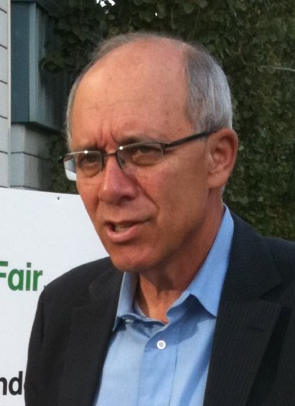
In the three years since she was selected as leader of the Wildrose Alliance, Ms. Smith has attempted, very publicly, to turn decisions made by Edmonton City Council into wedge issues in northern Alberta.
The most notable attempt was in 2010, when the Wildrose Party leader denounced the decision by City Councillors to implement a phased closure of the City Centre Airport, and used the conclusion of the long-standing and painful civic to wedge away traditional Tory support in northern communities concerned about what effects the closure could have on medivac and charter flight services.
While campaigning for the cancelation of the phased closure plans, Ms. Smith and her party started what became a personal battle against Mayor Mandel, who supported the phased closure. Despite the Wildrose Party’s incursion into municipal affairs, Mayor Mandel was re-elected with 55% of the vote.
Over the course of the next two years, and the 2012 election campaign, Ms. Smith’s party made issue of the provincial funding for a new Royal Alberta Museum and the renovation of the too-long abandoned Federal Building in Edmonton’s downtown.
These wedge issue did not translate into seats in northern Alberta on election day. The party’s candidates were competitive in many constituencies north of Edmonton, but only Lac La Biche-St. Paul-Two Hills candidate Shayne Saskiw was successful and the party’s only incumbent in the north, Fort McMurray-Wood Buffalo MLA Guy Boutilier, was defeated.

The Wildrose Party was also strongly rebuked in Edmonton, where in total votes it placed behind both the Progressive Conservatives and the New Democrats. Following controversial comments made on a blog by Edmonton Wildrose candidate Allan Hunsperger, Mayor Mandel cautiously waded into the election campaign. Voters in only one urban Edmonton-area constituency gave the party more than 30% support (in Sherwood Park).
Newly elected Cardston-Taber-Warner Wildrose MLA Gary Bikman believes his party’s drubbing in Edmonton was a result of rural voters “possessing more common sense” than the city dwellers, suggesting that Ms. Smith’s party may still have to undergo a significant psychological transformation before it will appeal to those nonsensical city voters.
The Edmonton’s Advantage
Simple geopolitics gives the two other opposition parties an advantage over the new Wildrose Official Opposition in the capital city. The leaders of of the two other opposition parties actually live there. The four MLA NDP caucus, led by Edmonton-Highlands-Norwood MLA Brian Mason, is entirely based in Edmonton and the former official opposition Liberal Party, led by Edmonton-Meadowlark MLA Raj Sherman, holds two seats in the capital city.
Even as a Calgary-based politician, PC Premier Alison Redford appointed some powerful Edmonton representatives at the cabinet table, including Deputy Premier Thomas Lukaszuk, Human Services Minister Dave Hancock, Health Minister Fred Horne, Culture Minister Heather Klimchuk, and PC caucus whip Steven Young. Just outside the city limits, Advanced Education Minister Stephen Khan, Education Minister Jeff Johnson, and Finance Minister Doug Horner represent constituencies in the Capital Region.
Despite Ms. Smith’s electoral posturing against the Mayor and City Council, and her party’s contingent of MLA’s hailing mostly from rural southern constituencies, Edmonton’s municipal officials will benefit from cultivating working relationships with the new Official Opposition. There will undoubtably be times over the next four years when the Mayor and City Council do not see eye to eye with the Government and that is when a healthy relationship with the bodies occupying the Official Opposition benches will be of benefit to Edmontonians.
With Ms. Smith’s party shut out of Edmonton, the city’s elected representatives do not owe anything to the Wildrose MLA’s, meaning that the Mayor and City Council can build relationships in their own time and on their own terms.
I have spent some time over the past week looking at the voting numbers from Monday’s general election and have created these maps showing the percentage of vote earned by each party. The most stunning change from previous election is the significant drop in support for Alison Redford‘s Progressive Conservatives in rural central and southern Alberta rural constituencies, which have given the PCs large majority votes in most elections over the past 40 years.
The strength of Danielle Smith‘s Wildrose Party was largely concentrated in rural central and southern constituencies, a few rural northern Alberta constituencies, and in south Calgary. Only one Wildrose candidate in an urban Edmonton-area constituency earned more than 30% of the vote (Garnett Genuis in Sherwood Park).
Rural Alberta was a vast wasteland for the Liberal Party and NDP in the 2012 election. Only in three rural constituencies did these two parties earn at least 11% of the vote (New Democrats Mandy Melnyk in Athabasca-Sturgeon-Redwater and Bruce Hinkley in Wetaskiwin-Camrose and Liberal Pete Helfrich in Banff-Cochrane.
Dr. Raj Sherman‘s Liberal Party found its only significant support concentrated in less than a dozen constituencies in central and west Edmonton and central and northeast Calgary. Support for Brian Mason‘s NDP was concentrated in central and north Edmonton constituencies and Lethbridge-West.
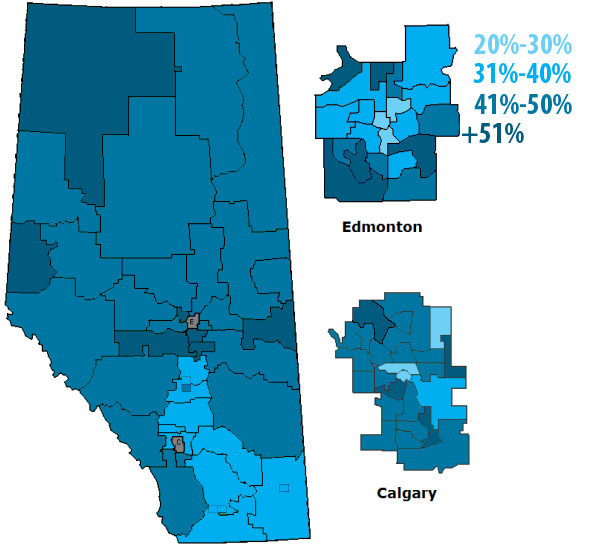
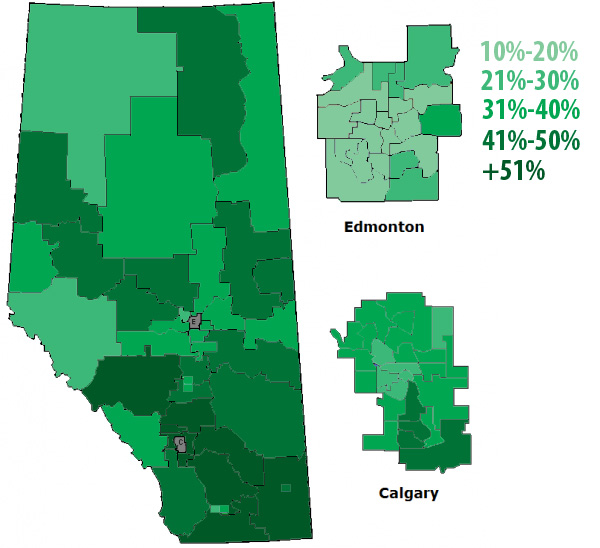
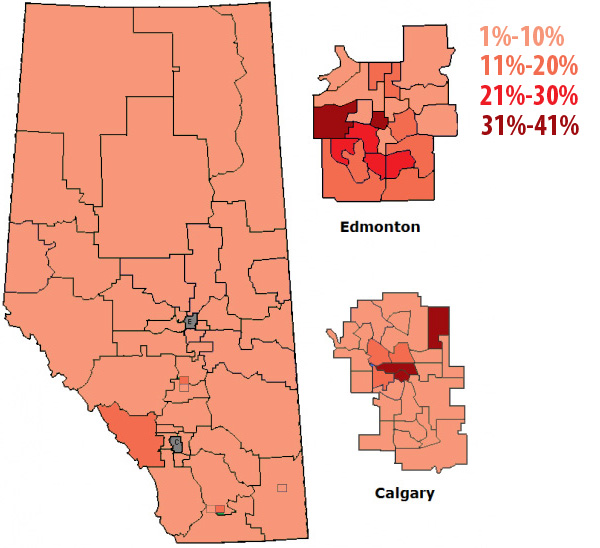
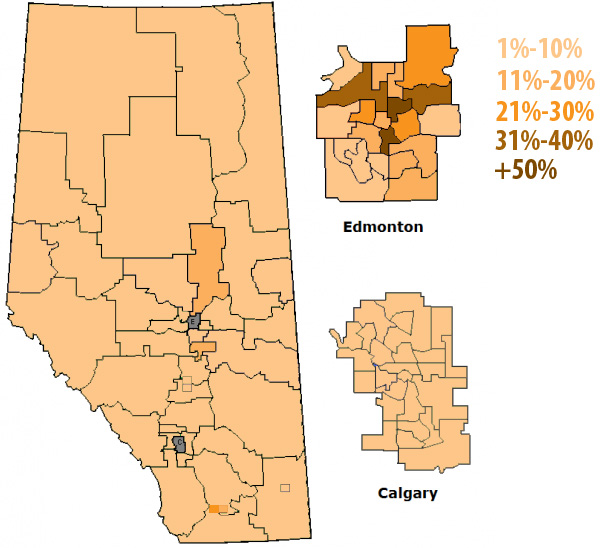
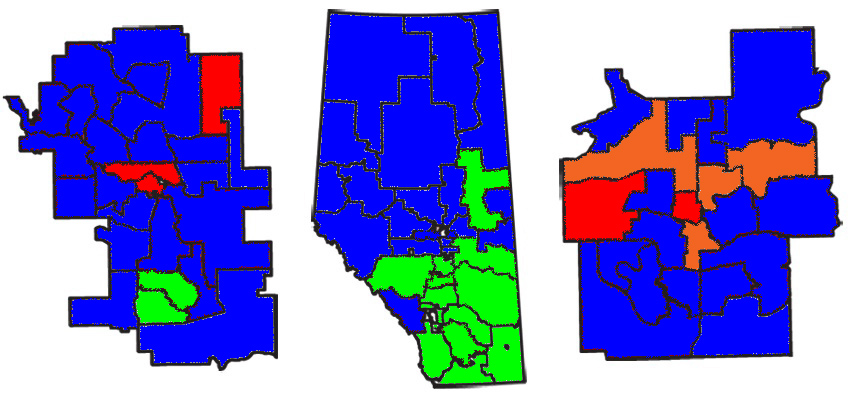
What was expected to be the most exciting provincial election in history of our province turned out to be a continuation of the 41-year old Progressive Conservative dynasty. The pollsters, the media, and the pundits (including this blogger) appear to have completely misjudged the electoral climate in the final days of the election.
Unofficial Results
PC: 61
Wildrose: 17
Liberal: 5
NDP: 4
It appears that the PC Party call to moderate voters to vote strategically to block the Wildrose Party from forming government was successful in Calgary, Edmonton, and northern Alberta. While the Tories ran a completely lacklustre campaign, Albertans’ unease with the thorny social conservative views of Wildrose candidates Allan Hunsperger and Ron Leech undoubtedly drew moderates to cast their ballots for the PCs yesterday.

At least for now, Premier Alison Redford is secure in her position as leader of the PC Party. The PCs have re-elected a number of veteran MLAs, including Dave Hancock in Edmonton-Whitemud, and a new cast of rookie MLAs who will amount to about 1/3 of the governing caucus.
The golden rule of Alberta elections remains truth: never bet against the incumbent.
The Tories have lost many of their former strongholds in rural Alberta and cabinet giants, including Ted Morton in Chestermere-Rockyview, Evan Berger in Livingstone-Macleod, Jack Hayden in Drumheller-Stettler, and Ray Danyluk in Lac La Biche-St. Paul-Two Hills. Successful use of wedge issues like property rights likely played a significant role in the Wildrose winning these rural constituencies.

With 17 MLA’s, Danielle Smith‘s Wildrose Party will form the Official Opposition in the Assembly. Ms. Smith’s challenges are two-fold. First, she must manage the expectations of disappointed caucus members who expected to be sitting in the government benches. Second, she must form a cohesive opposition consisting of mostly rookie MLA’s (including herself). Two of the Wildrose Party’s four incumbent MLA’s were defeated last night. Only MLA Heather Forsyth in Calgary-Fish Creek and Rob Anderson in Airdrie were re-elected.
The Wildrose caucus is almost entirely made up of MLA’s from southern rural Alberta constituencies, which breaks from the almost three decade-long tradition of urban-based Liberal or NDP official oppositions. This will be the first time since the Social Credit Party formed official opposition in 1971 that a large caucus of rural MLAs are the official opposition. Despite signs of a wave early in the campaign, the Wildrose Party only elected two MLA’s in Calgary, including Ms. Forsyth and Jeff Wilson, who defeated PC appointee candidate Farouk Adatia in Calgary-Shaw.

“It was a miracle that we survived” was Liberal Party leader Raj Sherman‘s comment on CBC Radio this morning. The Liberal Party elected five MLA’s last night, losing official opposition status for the first time in nineteen years. The Liberal vote collapsed across the province to 10% and the party lost long-time Liberal voting constituencies Edmonton-Gold Bar, Edmonton-Riverview, and Calgary-Varsity to the Tories.
Former Liberal MLA Maurice Tougas may have said it best on his blog this morning, “Liberals will now have to ask themselves what their place is in Alberta politics, or indeed if there is any place for them at all.”
The NDP probably have mixed feelings this morning. NDP leader Brian Mason ran a smooth campaign and his party has gained official party status by adding former MLA David Eggen from Edmonton-Calder and Deron Bilous from Edmonton-Beverly-Clareview to their caucus, but they are still one MLA smaller than the Liberals, who many New Democrats had hoped to surpass.
There are some pretty disappointed people in the Alberta Party camp this morning. Their hopes for electing an MLA were dashed, but the party earned 17,144 across the province, which leaves them with something to build on for the next election.
More to come…
In the final days of Alberta’s 2012 General Election, party leaders will be focusing their time and energy in the places that will matter on election day.
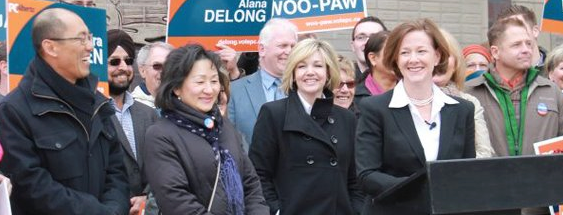
Progressive Conservative leader Alison Redford will spend the final day of the campaign making whistle stop appearances with Christine Cusanelli in Calgary-Currie, Alana DeLong in Calgary-Bow, Ken Hughes in Calgary-West, Cecilia Low in Calgary-Mountain View, Moe Amery in Calgary-East, Len Webber in Calgary-Foothills, and Manmeet Bhullar in Calgary-Greenway.
In past elections, most Calgary constituencies would be considered safe territory for the governing PCs. Since the beginning of this election campaign, polls have shown the Wildrose Party in a position to make significant gains across Calgary and Southern Alberta, putting many Tory incumbents and rookie candidates at risk of defeat.
With Wildrose Party candidate Ron Leech drawing fire after making some controversial racial comments, the Tories are undoubtedly hoping this controversy will translate into an advantage for their party in Calgary.
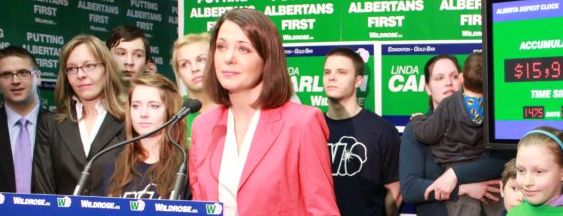
Also in Calgary tomorrow, Wildrose Party leader Danielle Smith will be making appearances at the at campaign offices of David Yager in Calgary-Hawkwood and Chris Challis in Calgary-North West, Richard Jones in Calgary-Acadia and Corrie Adolph in Calgary-Currie, and Dustin Nau in Calgary-Foothills.
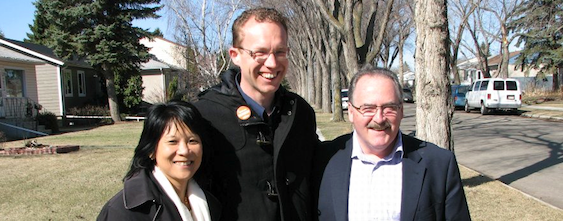
Toronto New Democrat Member of Parliament Olivia Chow was in Edmonton today campaigning with NDP leader Brian Mason in his Edmonton-Highlands-Norwood constituency, and making stops in Edmonton-Riverview, Edmonton-Manning and Edmonton-Gold Bar. The NDP are hoping candidates Lori Sigurdson, Cindy Olsen and Marlin Schmidt can make gains in these three constituencies.
The contest in Edmonton-Gold Bar will be very interesting to watch. Unlike the 2008 election, when incumbent Liberal MLA Hugh MacDonald‘s signs dominated front lawns across the constituency, this election’s lack of incumbent has opened up a three- or four- way competitive contest. Driving through the constituency it appears that Mr. Schmidt is holding his own against Liberal Josipa Petrunic and Progressive Conservative David Dorward.
Alberta Party leader Glenn Taylor will be where he should, campaigning in the Town of Hinton in the West Yellowhead constituency. Mr Taylor served as Mayor of Hinton from 2004 until January 2012. He recently recorded an online message to Albertans about why they should support his party on April 23.
Perhaps not where anyone would expect him to be during the last weekend of the campaign, Liberal Party leader Raj Sherman was scheduled to spend today in the traditionally conservative voting Red Deer, where the Liberals nabbed prominent local historian Michael Dawe as their candidate in Red Deer-North. Despite polls showing Liberal support has collapsed in Central Alberta, I would not be surprised to see Mr. Dawe do well on Election Night.
Dr. Sherman will spend the final day of the campaign in his Edmonton-Meadowlark constituency.
Tomorrow: The coveted daveberta election endorsements.
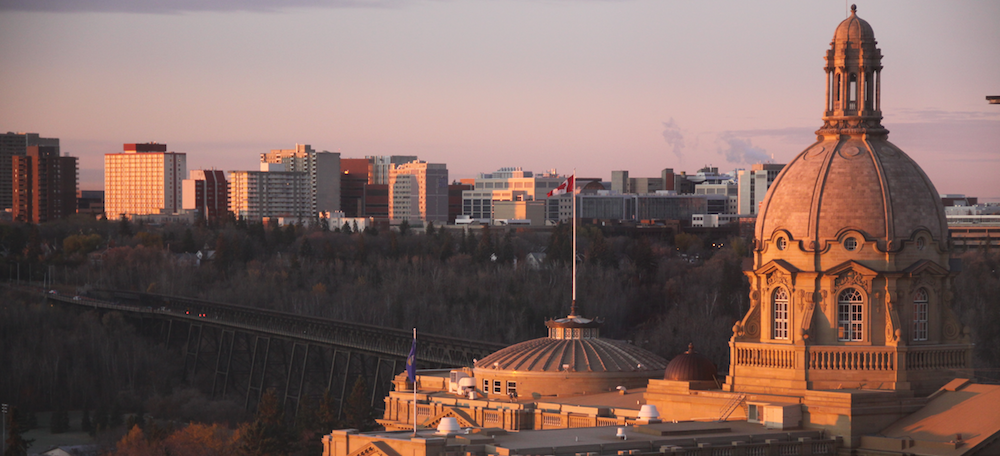
On Monday, Albertans will go to the polls in what is already being dubbed a “historic” election. The outcome is uncertain, so why not gaze into your crystal ball and enter the Daveberta and CalgaryGrit election pool. It is simple enough – predict the seat totals for each party and answer 10 bonus questions. Everyone gets 87 points minus one point for each seat you are off per party, plus two points per correct bonus question.
Robert Vollman has generously donated the following political book prize packs (shipping extra, unless we can arrange a pick-up in Calgary, Edmonton, or Toronto):
First choice goes to the overall winner, with the winners of the seat prediction portion and the bonus question portion also winning a book pack. So even if you are an Ontarian, like my friend Dan, with no clue what a “Ted Morton” is, never mind if he’ll win his seat, you can skip the bonus questions and still be eligible for the prizes, based on a shot-in-dark seat prediction.
Contest will close as soon as the polls open Monday. Please paste your entry in the comments here or at CalgaryGrit, or e-mail your picks in to david.cournoyer@gmail.com.
Election Results Questions
Number of MLAs elected by each party (total: 87 MLAs)
Bonus Question
1. The constituency where the PC candidate will earn their highest percentage of the popular vote:
(2008 results here; candidate list here; top ridings last time: Vermilion-Lloydminster (Lloyd Snelgrove – not running), Battle River-Wainwright (Doug Griffiths), Fort Saskatchewan-Vegreville (Ed Stelmach – not running), Bonnyville-Cold Lake (Genia Leskiw), Strathmore-Brooks (Arno Doerksen), Lac La Biche-St. Paul-Two Hills (Ray Danyluk))
2. Will PC MLA Ted Morton be re-elected in Chestermere-Rockyview?
(Morton won with 57% of the vote last time, but 308.com projects 22-point Wildrose win)
3. Will Premier Alison Redford be re-elected in Calgary-Elbow?
(Redford beat the Liberals by 3% last election, and 308.com projects her to beat the Wildrose by 3%)
4. Will Liberal Party leader Raj Sherman be re-elected in Edmonton-Meadowlark?
(As a PC, Sherman defeated the Liberals 54% to 30% in 2008)
5. What will the highest vote percentage for the Alberta Party be in a riding? (points if you’re within +/- 5%)
(Polls show them under 5% province-wide, but they’ve targeted a pair of Edmonton constituencies, including the one in Q7)
6. Will either Allan Hunsperger (“gays burn in hell”) or Ron Leech (“being white is an advantage”) win their seat?
(308.com projects Hunsberger to lose, but has Leech in a virtual dead heat)
7. Who will be elected in Edmonton-Glenora?
(Candidates: Sue Huff AP, Bruce Miller Lib, Ray Martin NDP, Heather Klimchuk PC, Don Koziak WR; 2008 vote: PC 40%, Lib 39%, NDP 15%, WR 2%)
8. Which party leaders will announce plans to resign within 48 hours of the vote?
(Alison Redford PC, Danielle Smith WR, Raj Sherman Lib, Brian Mason NDP, Glenn Taylor AP)
9. How many of the 3 senate positions will the Wildrose Party win?
(They’re running 3 candidates, the PCs are running 3 candidates, the Greens have 1 candidate, and there are 6 independents; full list here)
10. Who will get more votes – Liberals or NDP?
(current polls have them effectively tied)

Despite questioning climate science and refusing to remove one candidate who railed against a policy to protect sexual minorities in public schools and another who claimed his skin colour as a political advantage, Danielle Smith‘s Wildrose Party appears set to form a government after April 23.
If the Wildrose Party does succeed in electing enough MLA’s to form a government next Monday, unseating the 41-year governing Progressive Conservatives, Albertans should be asking themselves about which parties are best positioned to form effective opposition over the next four years? This election is as much about a change of government as it is about a change of opposition parties.

The PCs have governed the province since Peter Lougheed led that party to its first victory in the 1971 election. Behind in the polls for the past three weeks, Alison Redford‘s PCs have begun to quietly urge non-conservative urban voters to cast strategic votes for their party to block the chances of the Wildrose Party forming a government. With six days left in the election campaign, it may be too late for the PCs or urban voters to block a Wildrose government.
After four decades in government, there may be no one left in the PC Party who remembers what it is like to be an opposition party (or may no longer have an interest in supporting that party in opposition). As a conservative opposition party it is also unclear what policy differences it could present to contrast itself with a similarly conservative governing party. As a new website launched today reminds voters, the PC Party also has its share of MLA’s with extremist social conservative views.
The survival and success of the PCs as an opposition party may entirely depend on which Tory MLA’s are elected on April 23.
Voters who want more than two conservative voices in the Assembly should ignore the calls for strategic voting and cast their votes for the candidates and parties who best represent their views.

The Alberta Liberals, led by former Tory MLA Raj Sherman, have presented a good platform that focuses on health care, education, municipalities, and touches on controversial issues like tax increases.
From an experience standpoint, the Liberal Party’s slate of candidates includes a number of former MLAs, including Mo Elsalhy, Weslyn Mather, Bruce Miller, and Rick Miller, who served in the opposition benches from 2004 to 2008.
Unfortunately for the Liberals, being the official opposition since 1993 has not translated into their becoming the next government and the ingrained historical hostility felt by many Albertans towards the party suggests its chances of long-term growth are limited.

During this election campaign the NDP led by Brian Mason has focused on skyrocketing utility costs, taking a friendlier position towards resource development, and expanding and protecting public medicare. The NDP are in a good position to make gains in Edmonton. A number of NDP Members of Parliament, including Olivia Chow, Jack Harris, Niki Ashton, and Peter Julian are making campaign stops in the province during the final week of the election.
As an opposition party, the NDP would certainly provide Albertans with clear policy differences from both the PC’s and the Wildrose Party.
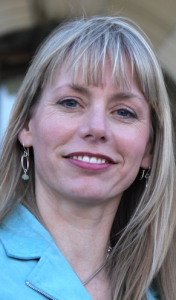
Over the next four years, the Alberta Party may be in the best position to help build a real centrist-progressive alternative to a Wildrose Party government. Despite having never elected an MLA, the party has been punching above its weight during this campaign in terms of organization and media coverage. The question will be whether the party can survive as a political movement if it does not succeed in electing an MLA.
Candidates like community organizer Michael Walters in Edmonton-Rutherford and former school trustee Sue Huff in Edmonton-Glenora have been running strong local campaigns, which could produce some surprising results on election day.
Last weekend, more than 100 Alberta Party volunteers delivered flyers to 5,500 homes in Edmonton-Rutherford in less than an hour.

After watching last night’s televised Leaders’ Debate, I am left wondering whether it will even have an effect on how Albertans vote on April 23. In many ways, the Leaders’ Debate felt like a microcosm of the entire election campaign. Here are a few of my initial thoughts on the leaders debate:
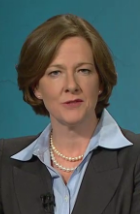
Progressive Conservative leader Alison Redford performed well while spending the bulk of the debate on the defensive fending off criticisms from all three of her political opponents. The other parties leaders honed in on issues like the MLA Committee Pay fiasco, which has proven to be a significant weakness for the PC Party in this campaign.
A skilled debater, Premier Redford handled her opponents criticisms well, though I am not convinced her own message was successfully delivered. If this was a big opportunity to turn around her party’s electoral fortunes, she surely did not make it worse.
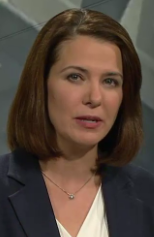
The main challenger, Wildrose Party leader Danielle Smith, was on the offensive and kept her eyes focused on the camera during the debate. She performed well, but floundered when providing some shaky and confusing responses to questions about her party’s positions on education and support of citizen initiated referenda.
Ms. Smith is a talented politician and an untested governor, and last night it showed. The debate was her opportunity to make the sales pitch to voters leaning towards her party and undecided voters. I do not think she did that.

He has experienced two previous televised Leaders Debates and in his third NDP leader Brian Mason was a secondary character. He succeeded in clearly differentiating himself from his two (or three, depending how you count) conservative political opponents on policy issues, but the debate steered clear of the issues most important to the NDP in this election (health care and electrical bills being two examples).
Liberal Party leader Raj Sherman was the wild-card entering this debate. I initially believed he was doing well, but as the debate went on, his over-rehearsed soundbites began to fall flat and his body language turned stiff. The Liberals have presented a good platform, but this debate suggests to me that Dr. Sherman might not be their best salesman.
Not invited to the debate, Alberta Party leader Glenn Taylor live-blogged his responses to the questions posed during the televised program.
The debate was exciting because we are in the midst of a rare competitive election, but it was not the battle of the titans that it was hyped to be. from the perspective of a viewer it suffered from the sterile television studio format. The set was devoid of life and the entire debate would have benefited greatly from the kind of energy that only a real life audience can create.
My call: There was no clear winner in this debate.

Tonight’s hotly anticipated televised Leaders’ Debate will be the first time that the four main party leaders have debated each other in this format. All eyes will be on Progressive Conservative Premier Alison Redford and Wildrose Party leader Danielle Smith, but do not count out veteran NDP leader Brian Mason or Liberal Party leader Raj Sherman, who is the wild-card in tonight’s debate.
Whether tonight’s debate will have an impact on how Albertans vote on April 23 is yet to be seen. Its relevance will entirely depend on the leaders’ performances and abilities to deliver a message that connects with Albertans.
The talented Jen Gerson, now with the National Post, has prepared a drinking game for the evening.
Alberta Party leader Glenn Taylor was not invited to join the debate and he will be live-blogging his responses to debate questions on his party’s website.
I will be live-chatting about the debate on Global Edmonton’s website with Calgary’s Joey Oberhoffner and Lethbridge’s Jeff Henry. I will also be talking about the election on CityTV’s Breakfast Television at 7:10am tomorrow.
If you are looking for a place to debate, the Edmonton-Calder NDP are hosting a debate party at candidate David Eggen‘s campaign office and the non-partisan folks behind Alberta Votes Matter will be watching the debate at Edmonton’s Suede Lounge.
Alberta is the most urbanized province in Canada (81% of the population living in urban areas) and the Edmonton-Calgary corridor is one of the most urbanized regions in Canada.
Looking to put cities on the provincial election agenda, Calgary Mayor Naheed Nenshi is using the CitiesMatter.ca website to weigh in on why it is important that Albertans know where the provincial parties and their leaders stand on the future of our urban centres. Mayor Nenshi has sent surveys to each of the parties asking them about their positions on urban issues. The surveys responses are expected to be posted on the CitiesMatter.ca website when they are returned.
University of Alberta professor Ian Urquhart, who is standing as an Independent candidate in Alberta’s Senate Nominee election has written about the role the Senate and the federal government could play in supporting our municipalities and the inequity that exists between the orders of government.
Dr. Urquhart correctly points out that even after the federal and provincial governments have downloaded more services and responsibilities to our municipalities, our cities receive a pittance of the revenue collected from Alberta taxpayers (just 8% in Alberta):
“From this small pot of money our cities must try to finance more than half of the infrastructure we use every day.”
Enthusiast of everything Edmonton, Mack Male, has joined a group of under-40 Albertans who are trying to put some important issues on the provincial agenda, like the expansion of Light Rail Transit in our major cities:
Edmonton and Calgary are often thought of as “car cities” but the desire to change is strong. Both cities have transportation plans that call for the expansion of light rail transit. Edmontonians consistently rank public transportation as the most important issue that the City should address. Most recently, a Leger Marketing poll showed that two thirds of Edmontonians would like to see the province fast-track its share of the LRT expansion to Mill Woods. In Calgary, Mayor Naheed Nenshi himself has been leading the charge to convince the province to provide long term and predictable funding for transit infrastructure in Alberta’s large cities.
Edmonton Journal columnist David Staples has suggested that the Wildrose Party’s proposed fiscal plan would axe the much needed transit funding, something that supporters of Danielle Smith has disputed (having an anti-LRT former mayoral candidate on her slate of candidates surely does not help reassure their critics). The Wildrose Party would cancel the existing Green Trip funding for future projects, but slot 10% of provincial tax revenues and 10% of surplus money for municipalities, which I understand could actually be less than the amount currently received through regular funding and special funds like GreenTrip (please correct me if I am mistaken).
Alison Redford‘s Progressive Conservatives have not released any strong policies on municipal funding during this election, but they have committed to increasing funding for libraries, which play an important role in communities, and continuing the successful safe communities initiative.
In their “Yes!” platform, Dr. Raj Sherman‘s Alberta Liberals have called for the drafting of City Charters, the creation of a Municipal Heritage Fund (which would include direct funding for community associations), and the reinstatement of Community Lottery Boards. As a former Edmonton City Councillor, NDP leader Brian Mason, supports an increased in funding for the GreenTrip fund. Mr. Mason was also one of the only MLA’s who spoke out against provincial funding for Daryl Katz‘s new Downtown Arena.
Led by former Hinton Mayor Glenn Taylor, the Alberta Party‘s municipal plan focuses on both urban and rural municipalities, Mr. Taylor also draws some strength from his past role as the chairman of the Rural Alberta Development Fund (whose board of directors includes former Tory MLA David Coutts and former Liberal leader Ken Nicol):
Some people will suggest that future Wildrose Party government heavy with conservative rural MLA’s would not understand the needs of our big cities. Although there is certainly a geographical divide in our politics (urban and rural, Calgary and Edmonton, small city and big city), fanning these flames will not move our province forward.
Urban enthusiasts worried about rural decision makers should remember that only a short time ago, it was a rural conservative leader, Ed Stelmach, whose government made some of the most important urban infrastructure investments of the past decade, including the creation of the GreenTrip fund.
In a typical provincial election in Alberta, the televised Leaders’ debate is a mere formality in a process that would inevitably lead to the election of another massive Progressive Conservative majority government. Even when the perceived winner of the debate is the leader of an opposition party, the effects on the governing party have been relatively minimal. In the last election, expectations were set so low for Premier Ed Stelmach that his satisfactory performance was seen as a big win for the soft-spoken and stuttering communicator.
The only televised Leader’s Debate during Alberta’s 2012 will be held on April 12 and it could be a spectacle not seen in this province in decades (CBC is hosting a Leaders’ forum, which will be broadcast on radio and live-streamed on the internet). It will be the first time that Premier Alison Redford and Wildrose Party leader Danielle Smith will debate each other face-to-face and also the first Leaders’ debate for three of the four main party leaders (it is Liberal leader Raj Sherman‘s first televised debate).
All eyes will be on Premier Redford and Ms. Smith.

The debate will be Premier Redford’s opportunity to turn the tide that has swept her 41-year governing Progressive Conservative Party into contention for official opposition status. Unlike her recent predecessors, she has the unfortunate task of having to answer for every misstep taken by her governing party for the past four decades.
This will be Premier Redford’s big opportunity to deliver a pitch to moderate conservatives, liberals, and undecided voters that voting for the more conservative and untested Wildrose Party just is not worth the risk. Despite a rough six months as Premier, she is a skilled debater.

Calm and confident, Ms. Smith has been preparing for this debate for years. Despite having never been elected as an MLA or faced any of her political opponents on the floor of the Assembly, Ms. Smith has honed her political debating skills on and off television as a columnist with the Calgary Herald, a brief stint as a school trustee, a director of a right-wing lobby group, and party leader since 2009.
With Ms. Smith’s party riding high in the polls, creating the real possibility that she could be our province’s next Premier, expectations will be set high for her to perform well in this debate. I would be surprised if she does not meet these expectations, but the other leaders will be marking targets on her party’s more controversial positions on conscience rights, de-listing abortion, attacking reporters, and privatizing health care. So far, the Wildrose leader has tried to avoid even commenting on most these issues, sticking to her highly disciplined and controlled campaign messaging.

Entering his third election as leader of Alberta’s NDP, Brian Mason has an opportunity to present Albertans with a clear alternative to the two leading conservative parties.
Following Ms. Smith’s announcement that her party would introduce more privatization into Alberta’s health care system, Mr. Mason jumped at the opportunity to get into the debate. With Edmonton-Calder candidate David Eggen by his side, Mr. Mason launched a campaign to “Save Public Health Care.” The NDP are polling well in Edmonton, with a recent Leger survey showing them with 20% support in the provincial capital, which has always been the centre of NDP support in Alberta.

For Dr. Sherman, who left the Tory backbenches in 2010 and now leads the official opposition Liberal Party, the debate will be his biggest opportunity to save his party from third party status or even being completely shut out of the Assembly. The Liberals became the official opposition in 1993 and since then their support has steadily declined (with the notable exception of the 2004 election when Kevin Taft led the party to double its seats in the Assembly).
Health care has been a key focus of Dr. Sherman’s campaign, and despite his professional expertise working in the Emergency Rooms of Edmonton’s hospitals, the Liberals have not been able to turn this strength into growth in the polls. Having earned a reputation for being sporadic when put on the spot, Dr. Sherman will be the wild-card in the April 12 debate.
Searching for the knock-out punch
The most interesting aspect of televised leaders’ debates, especially in elections where the results are not evident from the day the Writ is dropped, is that one misspeak or surprise Academy Award winning performance could potentially change the outcome on election day.
Most people will refer to Brian Mulroney‘s performance in the the 1984 federal election as the perfect example of a “knock-out punch“, but this clip from the 1991 British Columbia provincial election remains one of my favourite. Watch as Liberal leader Gordon Wilson delivers the most famous soundbite of that election, which helped take his party from zero seats in the Assembly to seventeen.
(Thanks to Colby Cosh, whose tweets inspired this post)
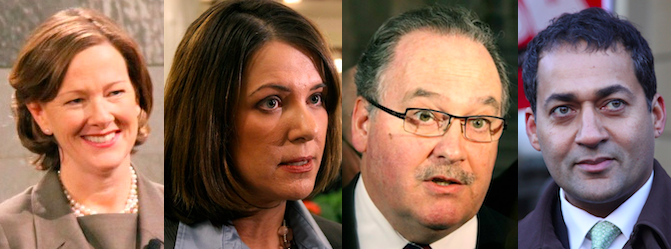
The televised Leaders’ debate for Alberta’s 2012 election will be aired on April 12 at 6:30pm to 8:00pm on Global Television.
The debate will include Progressive Conservative leader Premier Alison Redford, Liberal Party leader Raj Sherman, Wildrose Party leader Danielle Smith, and NDP leader Brian Mason. Some members of the Alberta Party have voiced disappointment that their leader Glenn Taylor was not invited to participate in the debate.
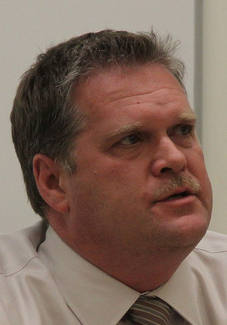
The Alberta Party gained a presence in the Assembly in January 2011 when former Liberal MLA Dave Taylor joined that party. Despite strong campaigns from candidates Michael Walters in Edmonton-Rutherford, Sue Huff in Edmonton-Glenora, Tim Osborne in St. Albert, and Norm Kelly in Calgary-Currie, recent polls have placed the party with 2% support province-wide.
If I were making the decisions, I would invite the leader’s from all the political parties to join the televised debate, but because the decision is being made by a private television company I can understand how they came to this conclusion. With only 30 candidates nominated in 87 constituencies, most viewers tuning in to the televised debate will not have the option of voting for an Alberta Party candidate on Election Day. The four other parties are expected to nominate candidates in all 87 constituencies.
What about past leaders’ debates that included parties with no elected MLA’s?
During the 1997 election, both NDP leader Pam Barrett and Social Credit leader Randy Thorsteinson were allowed to participate in the leaders debate. Neither of those parties had elected an MLA in the previous election. The Social Credit Party had not elected an MLA since the 1979 election. During the 2004 election, as the Alberta Alliance leader, Mr. Thorsteinson was not invited to join the televised Leaders; debate, despite his party having an MLA in the Assembly. Just before the election was called, Edmonton-Norwood PC MLA Gary Masyk crossed the floor to the new party.
There is no denying that the Wildrose Party is a force in this election campaign and should be represented in the televised debates, but it is important to remember that neither Ms. Smith or any of her party’s four incumbent MLA’s were elected as Wildrose candidates in the last election. Former leader Paul Hinman returned to the Assembly in a 2009 by-election and Heather Forsyth, Rob Anderson, and Guy Boutilier were elected as PC candidates in 2008 before crossing the floor to join the Wildrose Party in 2010.
Debate in front of an audience.
Instead of holding the televised debate in a sterile and controlled television studio, I would love to see the party leader’s demonstrate their debating skills in front of a live audience. A live audience would add an atmosphere of unpredictability and would force the leaders to speak to both the voters in the room and those watching their television screens.